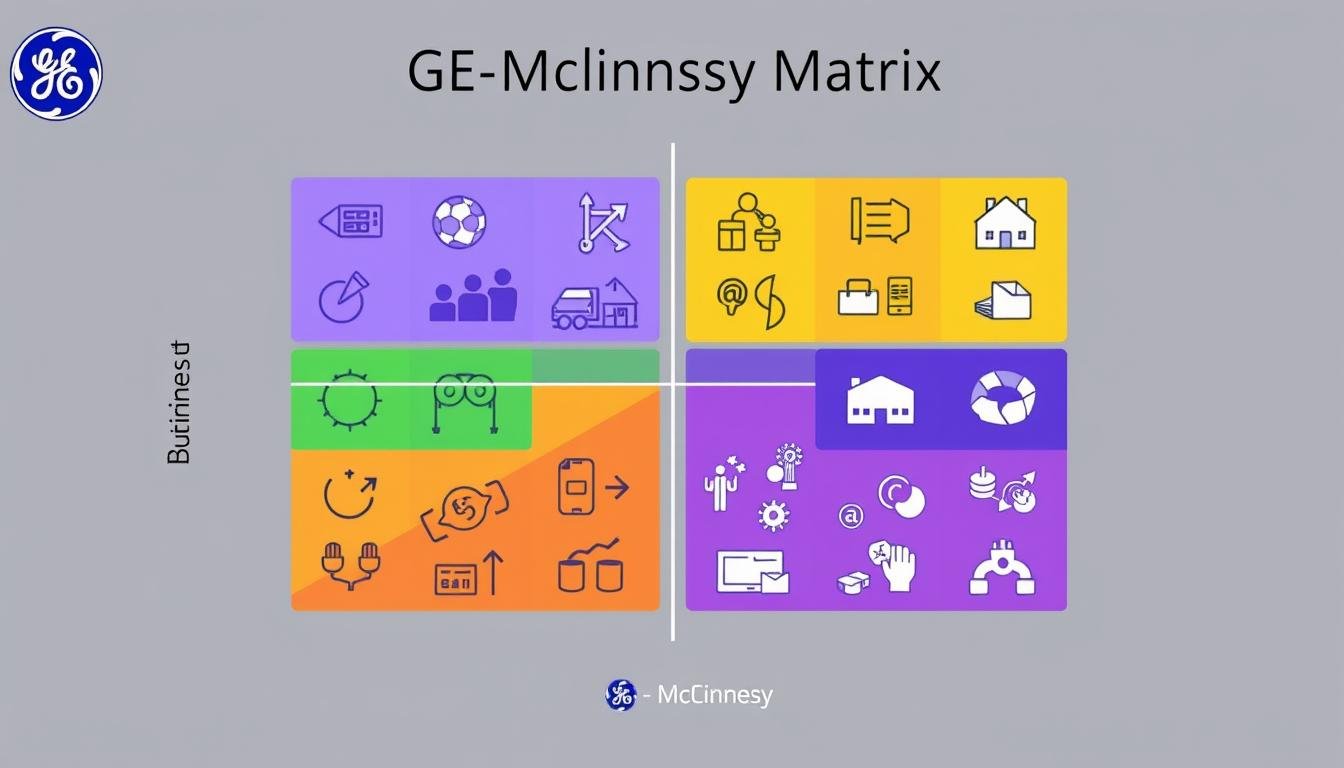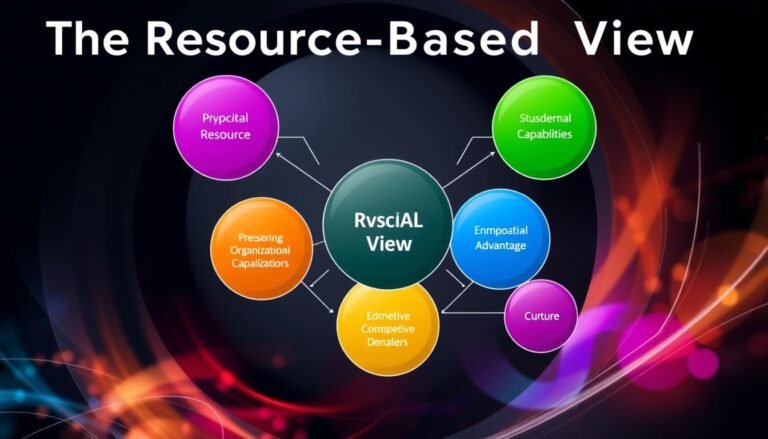GE-McKinsey Matrix Guide for Strategic Growth
Ever wondered how top companies pick where to spend their resources for growth? The GE-McKinsey Matrix is a key tool for strategic planning. It was created in the 1970s by McKinsey & Company for General Electric. This framework helps companies evaluate their business units and products carefully.
The GE-McKinsey Matrix uses a detailed 3×3 grid to look at market attractiveness and competitive strength. This tool helps companies make smart choices about where to invest. It guides them towards strategic growth and long-term success. We’ll dive into the details and benefits of this important tool, along with its limitations and how to use it well.
Key Takeaways
- The GE-McKinsey Matrix was created to help companies manage diverse strategic business units.
- This matrix categorizes business units based on industry attractiveness and competitive strength.
- It provides a framework for making informed investment and resource allocation decisions.
- The GE-McKinsey Matrix offers greater depth than simpler models like the BCG Matrix.
- Strategic scenarios within the matrix can include protect, harvest, and divest.
- Comprehensive data is essential for accurately positioning business units in the matrix.
Understanding the GE-McKinsey Matrix
The GE-McKinsey Matrix is a key tool for companies with many products. It was created by General Electric and McKinsey to help manage lots of product lines. It’s important to know how it works and how it differs from other methods for making good decisions.
History and Development of the Framework
In the late 1970s, the GE-McKinsey Matrix was introduced. It was designed for companies with a lot of products, often over 50. General Electric needed a way to decide where to put its resources.
Key Components of the Matrix
The matrix looks at two main things: how attractive the industry is and how strong the company is in it. These are rated as high, medium, or low, making nine cells total. The attractiveness looks at market size, growth, and profits. The strength looks at market share, brand power, and customer loyalty.
This helps companies decide where to put their resources to do better.
Comparison to the BCG Matrix
Unlike the BCG Matrix, which has a simple four-grid, the GE-McKinsey Matrix is more detailed with nine cells. This lets for a deeper look at each business unit. It shows which areas to invest in, focus on, or sell off.
How the GE-McKinsey Matrix Works
The GE-McKinsey Matrix is a powerful tool for strategic planning. It helps companies see where their business units stand. By using this matrix, businesses can make smart choices about where to use their resources. This is based on the market and their strengths.
Dimensions of the Matrix: Market Attractiveness and Competitive Strength
The GE-McKinsey Matrix looks at two key things: how attractive the market is and how strong the company is in it. It checks market size, growth, profits, and competition to see how attractive it is. It also looks at the company’s market share, customer loyalty, brand strength, and costs to see how strong it is.
Evaluating Business Units
Companies have many business units, each needing its own check-up. The matrix uses a rating system for both the market and the company’s strength. This helps understand where each unit fits in the company’s strategy.
Placement within the Matrix
Where a unit falls in the matrix tells what strategy to use: invest, hold, or divest. Companies work together to decide this, making sure everyone’s voice is heard. This helps them know where to put their resources for the best results.
| Matrix Position | Investment Strategy | Key Evaluation Factors |
|---|---|---|
| Invest and Grow | Focus resources for expansion | High market attractiveness and strong competitive strength |
| Hold and Protect | Maintain current investments | Moderate market attractiveness and competitive strength |
| Harvest and Divest | Reduce investments or sell | Low market attractiveness and weak competitive strength |
The GE-McKinsey Matrix: Benefits and Limitations
The GE-McKinsey Matrix is a key tool for companies with many businesses. It helps them see which areas have the most growth potential. It looks at two main things: how attractive the market is and how strong the company is in it.
This tool has many benefits but also some challenges. Strategic managers need to know these challenges.
Advantages of Using the Matrix
One big plus of the GE-McKinsey Matrix is that it helps decide where to invest. It looks at many factors to give a full view of each business unit. This way, companies can put their money where it can make the most difference.
- Accounts for multiple factors, providing a holistic view of performance.
- Visual simplicity allows for straightforward decision-making.
- Offers flexibility with nine placement options rather than just four.
- Highlights strategic growth potential more effectively than simpler models.
Challenges and Limitations
Even with its benefits, the GE-McKinsey Matrix has its downsides. For one, the scores can be subjective, meaning people’s opinions can affect the results. Also, getting accurate scores needs a lot of data, which can be hard to get and analyze.
- Subjective scoring may lead to inconsistencies.
- Requires in-depth knowledge of industry complexities.
- Overly simplistic in capturing dynamic market conditions.
- Lacks clarity on interrelationships between business units.
In conclusion, the GE-McKinsey Matrix is useful for companies with many businesses. But, it’s important to know both its good points and its downsides. This knowledge is key for making good strategic plans and managing well.
Implementing the GE-McKinsey Matrix in Strategic Planning
Using the GE-McKinsey Matrix in strategic planning needs a clear plan. Companies can do efficient portfolio analysis by following steps to make the matrix. This tool looks at market appeal and competitive strength to help evaluate business units. Knowing how to place products in the matrix helps make better decisions.
Steps to Create a GE-McKinsey Matrix
To make the GE-McKinsey Matrix, follow these steps:
- Gather Data: Collect data on market size, industry profits, and growth chances.
- Identify Key Factors: Look at what makes the market attractive, like trends and customer needs.
- Evaluate Competitive Strength: Check brand value, unique benefits, and market share to see each unit’s strength.
- Score Each Business Unit: Use a 1-10 score for market appeal and competitive strength.
- Plot the Units: Put SBUs in the 3×3 grid based on their scores.
Best Practices for Resource Allocation
For good business strategy, follow these tips on using resources:
- Invest in Growth Segments: Put resources in the top left corner for high profit potential.
- Manage Average Performers: Carefully use resources in the diagonal section to keep them going.
- Divest from Poor Performers: Look at products in the bottom left corner and decide if they need to be sold or changed.
- Communicate Clearly: Use the matrix to show departments and share priority decisions.
| Category | Strategy | Description |
|---|---|---|
| Invest/Grow | Growth Strategy | Needs more budgets and resources for growth. |
| Selectivity/Earnings | Hold Strategy | Does okay in a normal market, no extra resources needed. |
| Harvest/Divest | Harvest Strategy | Not doing well and might need to be sold in a tough market. |
By using these steps and tips, companies can make the most of the GE-McKinsey Matrix. This helps improve their strategic planning and business performance.
Conclusion
The GE-McKinsey Matrix is a key tool for companies looking to improve their portfolio and make better decisions. It plots business units on a 3×3 grid that looks at market appeal and competitive strength. This helps companies see where to invest more and where to cut back.
By looking at things like market share and customer loyalty, the matrix helps with smart resource use. Units in the top right corner are great for growth and should get more investment. On the other hand, units in the bottom left corner might be good to sell off, keeping the portfolio balanced.
The matrix also helps companies stay flexible and adapt to market changes. By regularly checking their strategies, businesses can grab new chances and tackle problems. In the end, using the GE-McKinsey Matrix helps companies make smart moves for long-term growth.
Source Links
- Complete guide to application of GE-McKinsey Matrix
- GE Matrix: The Ultimate Resource Allocation Tool for Growth | Lucidity
- Strategic Analysis with GE-McKinsey Matrix – Vast Thinking Consults Ltd
- GE McKinsey Matrix: The Ultimate Guide – SM Insight
- GE McKinsey Matrix
- GE-McKinsey Matrix – MBA Crystal Ball
- The GE-McKinsey Matrix: an analysis and strategic decision-making tool – Templates | Klaxoon
- GE McKinsey Matrix – Strategy & Portfolio Training from EPM
- GE McKinsey Matrix: How To Apply it To Your Business
- All about GE-McKinsey Matrix
- How can you use the GE McKinsey Matrix to analyze your business?
- GE McKinsey Matrix EXPLAINED with EXAMPLES | B2U
- Guide to the GE McKinsey Matrix
- McKinsey GE Matrix: Importance & How To Use It (2024)
- A Complesive Analysis in Corporate Strategy







